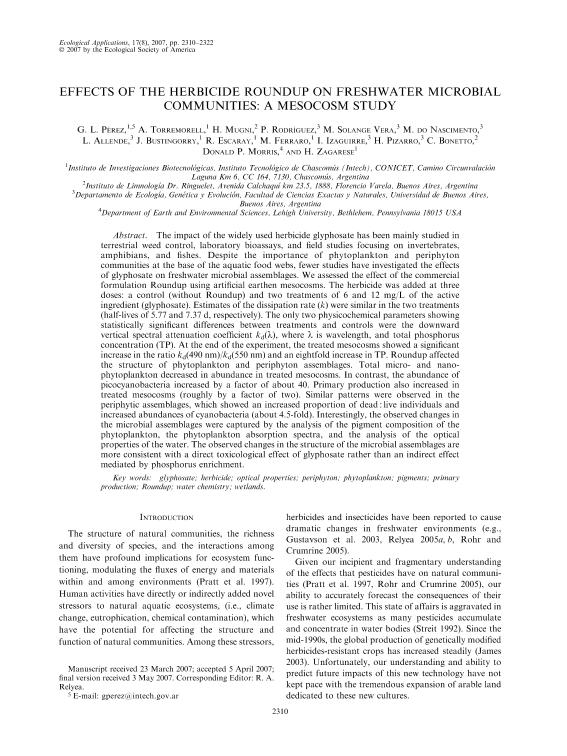Artículo
Effects of the herbicide Roundup on freshwater microbial communities: a mesocosm study
Pérez, Gonzalo ; Torremorell, Ana María
; Torremorell, Ana María ; Mugni, Hernan Diego
; Mugni, Hernan Diego ; Rodriguez, Patricia Laura
; Rodriguez, Patricia Laura ; Vera, Maria Solange
; Vera, Maria Solange ; Do Nascimento, Mauro
; Do Nascimento, Mauro ; Allende, Luz
; Allende, Luz ; Bustingorry, Jose Fernando
; Bustingorry, Jose Fernando ; Escaray, Francisco José
; Escaray, Francisco José ; Ferraro, Marcela Andrea; Izaguirre, Irina
; Ferraro, Marcela Andrea; Izaguirre, Irina ; Pizarro, Haydee Norma
; Pizarro, Haydee Norma ; Bonetto, Carlos Alberto
; Bonetto, Carlos Alberto ; Morris, Donald P.; Zagarese, Horacio Ernesto
; Morris, Donald P.; Zagarese, Horacio Ernesto
 ; Torremorell, Ana María
; Torremorell, Ana María ; Mugni, Hernan Diego
; Mugni, Hernan Diego ; Rodriguez, Patricia Laura
; Rodriguez, Patricia Laura ; Vera, Maria Solange
; Vera, Maria Solange ; Do Nascimento, Mauro
; Do Nascimento, Mauro ; Allende, Luz
; Allende, Luz ; Bustingorry, Jose Fernando
; Bustingorry, Jose Fernando ; Escaray, Francisco José
; Escaray, Francisco José ; Ferraro, Marcela Andrea; Izaguirre, Irina
; Ferraro, Marcela Andrea; Izaguirre, Irina ; Pizarro, Haydee Norma
; Pizarro, Haydee Norma ; Bonetto, Carlos Alberto
; Bonetto, Carlos Alberto ; Morris, Donald P.; Zagarese, Horacio Ernesto
; Morris, Donald P.; Zagarese, Horacio Ernesto
Fecha de publicación:
01/12/2007
Editorial:
Ecological Society of America
Revista:
Ecological Applications
ISSN:
1051-0761
Idioma:
Inglés
Tipo de recurso:
Artículo publicado
Clasificación temática:
Resumen
The impact of the widely used herbicide glyphosate has been mainly studied in terrestrial weed control, laboratory bioassays, and field studies focusing on invertebrates, amphibians, and fishes. Despite the importance of phytoplankton and periphyton communities at the base of the aquatic food webs, fewer studies have investigated the effects of glyphosate on freshwater microbial assemblages. We assessed the effect of the commercial formulation Roundup using artificial earthen mesocosms. The herbicide was added at three doses: a control (without Roundup) and two treatments of 6 and 12 mg/L of the active ingredient (glyphosate). Estimates of the dissipation rate (k) were similar in the two treatments (half-lives of 5.77 and 7.37 d, respectively). The only two physicochemical parameters showing statistically significant differences between treatments and controls were the downward vertical spectral attenuation coefficient kd(λ), where λ is wavelength, and total phosphorus concentration (TP). At the end of the experiment, the treated mesocosms showed a significant increase in the ratio kd(490 nm)/kd(550 nm) and an eightfold increase in TP. Roundup affected the structure of phytoplankton and periphyton assemblages. Total micro- and nanophytoplankton decreased in abundance in treated mesocosms. In contrast, the abundance of picocyanobacteria increased by a factor of about 40. Primary production also increased in treated mesocosms (roughly by a factor of two). Similar patterns were observed in the periphytic assemblages, which showed an increased proportion of dead : live individuals and increased abundances of cyanobacteria (about 4.5-fold). Interestingly, the observed changes in the microbial assemblages were captured by the analysis of the pigment composition of the phytoplankton, the phytoplankton absorption spectra, and the analysis of the optical properties of the water. The observed changes in the structure of the microbial assemblages are more consistent with a direct toxicological effect of glyphosate rather than an indirect effect mediated by phosphorus enrichment.
Palabras clave:
Glyphosate
,
Microbial Communities
,
Mesocosms
,
Water Quality
Archivos asociados
Licencia
Identificadores
Colecciones
Articulos(IEGEBA)
Articulos de INSTITUTO DE ECOLOGIA, GENETICA Y EVOLUCION DE BS. AS
Articulos de INSTITUTO DE ECOLOGIA, GENETICA Y EVOLUCION DE BS. AS
Articulos(IIB-INTECH)
Articulos de INST.DE INVEST.BIOTECNOLOGICAS - INSTITUTO TECNOLOGICO CHASCOMUS
Articulos de INST.DE INVEST.BIOTECNOLOGICAS - INSTITUTO TECNOLOGICO CHASCOMUS
Articulos(ILPLA)
Articulos de INST.DE LIMNOLOGIA "DR. RAUL A. RINGUELET"
Articulos de INST.DE LIMNOLOGIA "DR. RAUL A. RINGUELET"
Articulos(OCA CIUDAD UNIVERSITARIA)
Articulos de OFICINA DE COORDINACION ADMINISTRATIVA CIUDAD UNIVERSITARIA
Articulos de OFICINA DE COORDINACION ADMINISTRATIVA CIUDAD UNIVERSITARIA
Citación
Zagarese, Horacio Ernesto; Morris, Donald P.; Bonetto, Carlos Alberto; Pizarro, Haydee Norma; Izaguirre, Irina; Ferraro, Marcela Andrea; et al.; Effects of the herbicide Roundup on freshwater microbial communities: a mesocosm study; Ecological Society of America; Ecological Applications; 17; 8; 1-12-2007; 2310-2322
Compartir
Altmétricas



